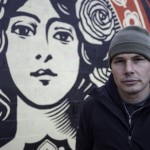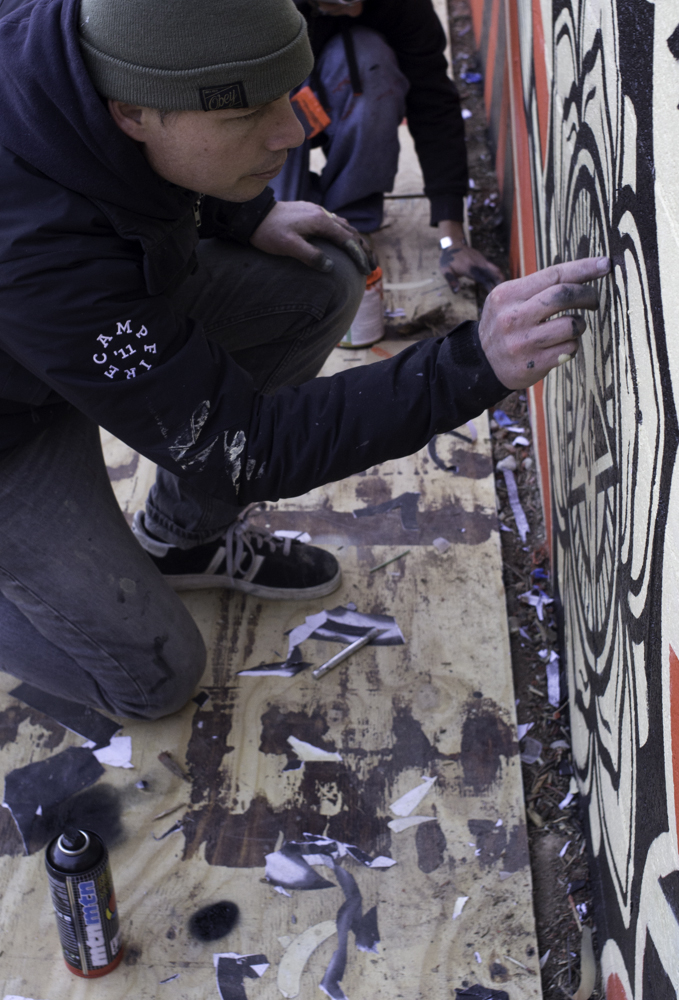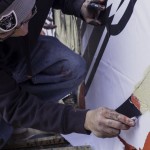Tags
Related Posts
Share This
15 Minutes of Hero Worship with Shepard Fairey
Last week, internationally renowned graphic artist Shepard Fairey painted a mural at Santa Fe University of Art and Design. Most students here, including myself, eagerly awaited his arrival, posting Facebook statuses, and antagonizing friends at other colleges who didn’t have Shepard Fairey painting a mural there.
I’m a big fan of Fairey’s work, especially his Obey campaign, and his uncompromising style, so I was looking forward to getting a picture or something with him.
My excitement doubled when I managed to squeeze myself into Fairey’s busy schedule to secure an interview for my journalism class. Who needs a picture or an autograph when I can actually sit down and talk to the man? With all the excitement, though, came fear. What could a second- year art student ask Fairey that a seasoned journalist hadn’t already covered?
All Monday, students gathered around Fairey, who was making tremendous progress on his black and red ode to art. Some managed to get pictures with him. Others got some Obey stickers autographed. Junior Randy Martinez even had the opportunity to assist Fairey with some of the stencil work. As long as Fairey was painting, there were no fewer than 20 students watching him work. I had class all day so I didn’t get to join them. However, I did overhear the Public Enemy and NWA that he was listening to while working, which took him from a man I admired to a man I thought was the coolest on the planet.
The next day, photographer Natalie Abel and I waited patiently outside a conference room, conversing about how nervous we were for the interview. Finally, SFUAD’s PR official, Lauren Eichmann, called us into the room.
Upon entering the room, my immediate thought was that despite us both being about 5’11,’’ Shepard Fairey is a short man. I don’t know what it is about celebrity that alters expectations but I expected him to be at least 7 feet tall. Fairey appeared tired, which made sense considering the cold temperatures outside and the many hours he had already spent on the mural. He was decked in apparel from his clothing line, which at first seems narcissistic, but upon further reflection, if I had my own clothing line I wouldn’t pay for clothes either.
Natalie and I introduced ourselves to Fairey, who extended his paint-covered hand for a handshake. I was notified beforehand that once I was in the room I would need to wait my turn, as the Frontier blog had a conference call interview with Fairey first.
Two Frontier bloggers from New Zealand interviewed Fairey for close to 40 minutes, asking him questions about his humble beginnings as an artist and about Shepard’s most famous work, The Obama Hope poster. Most of his answers one could find on his Wikipedia page, though it was interesting to hear him talk about obscure late 80’s album covers and the skateboard culture that influenced much of his early work.
The Frontier bloggers thanked Fairey for his time, and Fairey returned their politeness before ending the call. I flipped through my notebook, nervous and trying to find the first question.
Prominently displayed on the mural is the phrase “Make Art Not War,” so I figured I would start with what the phrase means to him and what he wanted it to mean for the students of SFUAD.
“What I felt was the best approach, was something more open to interpretation,” Fairey said. “Something that was about looking at art as a positive alternative to war and how each person would use their art as an alternative to war is up to them. I see creativity leads to recognizing humanity in others, to be compassionate towards others.”
That was a great answer to a question that I’m sure every media outlet had already asked him. Having asked one explicitly journalistic question that I probably could have written a serviceable piece about, I decided it was time to selfishly take advantage of this chance to ask Fairey some questions that had been bothering me.
In my research of old articles and blog posts, I had seen a disturbing trend of Fairey’s critics decrying him as a sell-out. So, for the first of my real line of questions for Fairey, I asked him if when art and commerce cross paths it diluted the message?
“I don’t think so,” said Fairey. “People are always talking about the concept of selling out. To me selling out is compromising what you’re doing to please someone else because they’ll give you money. Now if you are doing what your natural inclination is, and people find value in it, and are willing to reward you for it, that’s a byproduct of doing something with merit.”
Fairey went on to talk about his early years when he would work as a graphic designer to fund his art projects. He feared that if he was too inflammatory with his art work that people would be reluctant to hire him as a graphic designer. Ironically, it was his inflammatory nature that led to more commercial success.
“Once I started to succeed more, people were saying ‘we like what your message is and we want to buy a painting of that,’ and that meant I had even less to worry about in terms of self censorship as my art practice became more self sustaining.”
Satisfied, and a bit envious, with his answer I moved on to my next, and most anticipated, question: Does the romantic vision of the starving artist still exist?
“Some people want to have no pressure. They are happy to be doing what they’re doing with no commercial expectations. They’re happy to be broke. I think that that’s perfectly fine too,” said Fairey.
“What I find with some people though, is they’re actually terrified of rejection. They say they’re ‘keeping it real,’ but what they’re really doing is being a coward. There is a big difference between keeping it real and being a coward.”
Again I couldn’t be happier with his answer. Everyone appreciates being agreed with, but when Shepard Fairey agrees with you, it’s hard not to feel moral superiority.
I also asked Fairey whether commercial success deserves merit by itself, which was a bit of a retread on an early question, which led to a nice little tangent on Andy Warhol, whose use of iconography bears some resemblance to Fairey’s own work. Ultimately, Fairey concluded that regardless of commercial success: “Just examining things in a sophisticated way is important.”
Notified that I was low on time, I moved to my last question. “What do you want from the next generation of artists and what do you want to see from us?” If I’m being honest with the way the interview was unfolding, the question could have easily been, “How can I be cool like Shepard Fairey?”
“I didn’t have any expectations when I came here,” said Fairey. “It’s usually a mixed bag when I deal with people from art schools. I think artists are naturally competitive. I remember people tearing each other down at RISD [Rhode Island School of Design] in critique, talking badly about so and so. There’s always that competitive aspect to it. I get some people saying they love what I do, and others saying it’s garbage. Most people here have been really friendly, and it seems that they are trying to do constructive things with their work.”
Even though it is proper interview etiquette to hold eye contact, I still couldn’t help feeling he said I was doing a good job.
“All I think that artists should try to do is approach their art to achieve something that’s about uplifting humanity rather than being purely vain and narcissistic. There’s a lot of vanity in art and I get it, but I think if you have the ability to make something beautiful it doesn’t just have to serve your own vanity; it can serve more than that and at the same time serve your vanity, because people will love the work, and they’ll love you for it, but it doesn’t have to just be selfish.”










 Jackalope Magazine is the student magazine of Santa Fe University of Art and Design. Building on the interdisciplinary nature of our education, we aim to showcase the talent of our university and character of our city.
Jackalope Magazine is the student magazine of Santa Fe University of Art and Design. Building on the interdisciplinary nature of our education, we aim to showcase the talent of our university and character of our city.